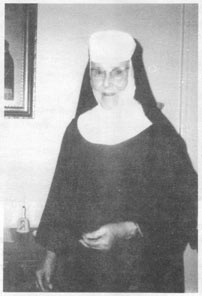The Story of a Sister
|
On August 15th, the Feast of the Assumption of the Blessed Virgin Mary, Marlene Bettale received the habit as an Oblate Sister of the Society of St. Pius X at Queen of Angels in Dickinson, Texas, where she now teaches. This event marked the completion of a full circle in Marlene's career. Growing up in St. Louis, Missouri, she there entered the Order of the School Sisters of Notre Dame, completed her B.A. in Art Education at Notre Dame College in St. Louis, taught in various elementary schools and spent thereafter many years teaching Art and English in high school. In the years that followed she taught in both the public and Catholic school systems before eventually finding the traditional Church and coming to Dickinson, Texas. When she received the habit this past August, she took the name of Sister Marie Celeste, the same name she had as a Notre Dame Sister. The story of her vocation and how God led her back to the convent is the subject of this interview which was conducted by Father Daniel Cooper. We hope other women will find comfort in Sister Marie Celeste's story and be encouraged to dedicate, or re-dedicate, their lives to Our Savior. |
Sister Marie Celeste, what made you originally want to become a nun?
It was the wonderful instruction and the beautiful example of the Notre Dame Sisters in grade school that first led me to become a religious and a teacher.
Was there any nun in particular?
On a spiritual level I remember Sister Alfredine, my second grade teacher. She taught me to love God and to speak to God as a close friend. The Notre Dame Sisters were wonderful; they were everything religious should be... I grew so close to God by their instruction, their stories, the pictures they painted of Christ and His love. This planted a seed securely in my soul. My mother also had a deep-seated faith and often spoke of "God's holy will." Then, in high school, Sister Lucienne, my religion and home economics teacher, was someone I was very close to. It was she who approached me in my senior year and said, "Marlene, I have been praying for vocations and I had never thought of you before, but have you considered becoming a religious?" I told her I had and she immediately contacted her religious superiors.
How old were you when you entered?
I entered in August, right after my senior year; I was 17.
How did your family react?
My mother thought that being a religious was wonderful, but that I was not good enough for such a high office. (Priests and religious were next to saints and she couldn't imagine one of her children becoming one!)
My father gave me two months—"You'll be back." My brothers thought it was a joke. But after a few months I could see the pride growing in my father's eyes. My mother said he showed my picture to everyone.
How would you describe the Order you belonged to?
I was educated primarily by the School Sisters of Notre Dame, at that time one of the largest teaching orders in the world. I had them in grade school, high school, and then in my postulant and novitiate years in the Motherhouse. They were excellent educators, having been founded for the poor—originally in Europe, but later in America— teachers in all facets of education, even on the university level. I remember that some of the sisters on the college faculty were doing research projects for the government. One of them was considered a top mathematician in the country. I was always proud of them and loved what they stood for. They reminded me of the Blessed Mother in many ways; they were modest and loving.
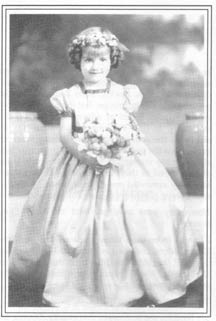 Marlene Bettale, age 4 |
How many years were you with the Notre Dame Sisters?
I taught more than twenty years with the Notre Dame Sisters, both as a religious and later as a lay person. I taught in five different states, but most of the time in New Orleans. I was a Sister myself for fourteen years.
Why did you leave the Notre Dame Sisters?
It's hard for me to answer that exactly. During the 1960's it was obvious that much of the world had entered the convent, but it happened so gradually over the years that I didn't realize it. Children who came to us for counsel beforehand, now seemed distant and felt that we wouldn't understand their problems. Sisters began to leave the community and live in apartments in groups of two or three; some had their own cars. I didn't feel the wonderful spirit we had once offered to children was there to give anymore, and apparently they didn't feel so either. That's why they didn't feel comfortable talking to us anymore. The Rule became lax; television was an everyday activity; the habit was changed, finally to a black suit with no veil—we became secularized. I came to believe that I could do more outside the convent than in.
What did you do when you left?
I began teaching in the public school system. I had to go there because I needed a higher income than the Catholic schools could afford. After four years I was able to return to Redemptorist High School, where I had taught as a religious. They had asked me two years earlier, but I had too much indebtedness to accept the large salary cut it entailed.
What made you quit teaching?
Several years had passed and I was getting progressively disturbed with the high school liturgies, the terrible things taught in religion class, and generally the lack of traditional Catholic spirit I had known in earlier years. It was gone! The children had become like some of the public school children with no religious base. This made me choose to retire from teaching, which I did in June of 1987. Not only did I feel that I should retire, but I also had an inner conviction that I had to leave New Orleans. Though I had been there many years, had many friends, a good income, beautiful apartment, and loved the city, I just knew I had to leave. So I returned to St. Louis that summer.
What did you do in St. Louis?
Because of my art background, I decided to get a job in the graphic arts field. I had taught layout/design in a vocational school in New Orleans for six years and felt qualified to work in some facet of advertising. I finally settled in a desktop publishing position.
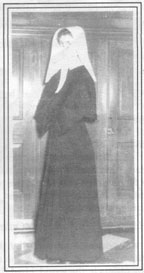 A Notre Dame Postulant |
How did you become involved with the Society of St. Pius X?
Actually I was unhappy working in St. Louis and my long drives back and forth to work gave me plenty of time to think and pray. I asked God to guide me because I knew He hadn't asked me to return to St. Louis for nothing. Soon after, on a Saturday morning, I decided to take a bicycle ride and found myself coasting down a hill, with no brakes, toward a four-lane thoroughfare. I tried to turn into a parking lot, but my tire hit the curb and I was thrown over the handlebars ten feet into the street. The accident placed me in the hospital with a broken collarbone, several broken ribs, a concussion and many lacerations.
It's surprising you weren't killed!
It is. I was told later that a car swerved to avoid hitting me.
Well, what happened then?
I had to give up my apartment and move in with my mother; my entire right side was in a brace. Even after many weeks of slow healing I knew I was too weak to get back into a full day's work. It was at this time that I realized to what extent God had gone to get my serious attention—something like St. Paul getting knocked off his horse—in my case, it was a bicycle. I really didn't know what to do now. I had financial obligations that weren't being met. Just about this time a woman, who had remained a close friend of mine since I had taught her in grade school, came to my rescue. Perhaps I should say the Holy Ghost came to my rescue through her. She called me in the name of her pastor, Father Hogan, of Queen of the Holy Rosary Church (the Society's chapel in St. Louis). At that time he needed someone to cook just the noon meal for the priests. I took the job with the idea that I would only be there a short time. I needed some kind of income. I went to Mass there and after just two Masses all my religious life came back to me. It had been over twenty years since I had attended the true Mass. I started to go to Mass every day and then I started to come early to hear the priests chant their morning Office. I received such graces during that period of time that I cannot even express it. It brought me back to my childhood when I used to follow the Mass before school.
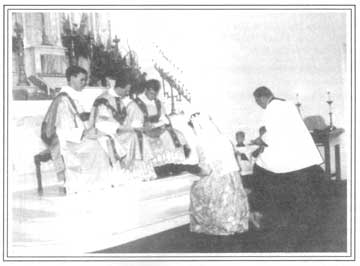 Presentation of the Habit for blessing |
Was it at this time that you decided to return to the religious life?
No, not yet, but after a couple of months I did begin to realize that I wanted to dedicate the rest of my life to the traditional Church, but not necessarily as a religious. I felt that the only way was through the Society of St. Pius X.
How did you end up at Queen of Angels, in Dickinson, Texas?
Soon after that I told Father Hogan of my intentions. He spoke with Father Laisney but I received no encouragement at first.
Why not?
I don't know, but not long after that Father Hogan came to me in the kitchen and asked, "How would you like to teach in Dickinson, Texas?" My reaction was utter surprise. I thought I had been refused but, after I caught my breath, I said, "Sounds like an answer to my prayers!"
You had wanted to go back to teaching?
It didn't make any difference what I did. I could cook, teach, do sacristy work, or work in publications, but I didn't know in what capacity the Society needed me. Father Laisney told me of his need for a teacher in Texas; he encouraged me now. I would be living in the convent at Queen of Angels with the Sisters and it was at this time I asked to work with the hope of becoming a religious in the future.
When did you finally get to Texas ?
Well, at first, they told me it would be in three months, but circumstances changed and, in three weeks, I was driving down. It was February 10, 1989. My nephew, Brett, volunteered to help me pack the car and drive me down. We arrived February 11 and I began teaching February 13!
How did you feel about living with Sisters again?
I had spoken with Sister Grace, the Superior, on the telephone and she seemed very warm; all the Sisters seemed eager to have me. I was looking forward to it and fell right into convent routine with no problem. I belonged here.
What Order are the Sisters at Queen of Angels Convent?
Every Sister is from a different Order! Sister Grace is a Benedictine, Sister Carmela is a Carmelite, Sister Vianney is from the Society of St. Pius X, and although she has gone to our Davie, Florida chapel to open a new school, Sister Anthony Therese, a Dominican, was also here.
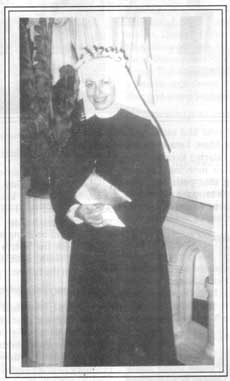 Sister Marie Celeste—home again! |
How did such a variety of religious end up at Queen of Angels?
Each of them left their religious communities because they could no longer accept the Modernism that had entered the convent. They became intolerant of the great differences in the Mass. Queen of Angels, with the traditional Mass, school and convent, became a welcome home for them. Living with the Sisters I saw that they had given up everything, even their own religious communities—which some had belonged to for over 45 years! They had to sacrifice even this for what they knew was the truth, carried forward only by the traditional Church. The Society of St. Pius X took them in, as a Shepherd would take in His sheep caught in the briars. It wasn't until this year that I realized personally the great privilege of being accepted into the Society of St. Pius X. What other group exists today that is doing more the work of God and furthering more His holy Church?
Is there something you would say to other women like yourself concerning their interests in helping the traditional Church?
Well, I suppose the first thing I would say is that I know there must be many of you out there, men and women alike. I say then, "Pray, pray, and pray some more." I know that God is giving special graces to those who are truly searching for the way to spread His Church. Some of you are former religious, some older men and women who are widowed, and whose children are grown. Some of you are seeking an outlet to return to God what He has so generously given you in earlier years of your life. Pray and God will show you the way.
If you are free to seek out places where the Society works in this country or even abroad and offer your services, do so! There are needs for every skill and talent possible. One of the big problems is that we cannot house, for the most part, our "laborers in the vineyard." For women under thirty seeking to be religious, there is our Motherhouse in Armada, Michigan. But older women need to be able to live on a shoestring or even be self-supporting to work for the Church. We are truly poor. "Blessed are the poor..." At a few of our larger chapels, or at St. Mary's in Kansas, workers of many skills are needed. "The harvest is great..."
For those of you who have "ties," your prayers and financial support represent the type of gift God is asking of you. Surely the work of the Church could not be done without these. Support your nearest Society chapel and do what you can to make it grow.
Prayer is the foundation stone of all of God's work. For He is really the Miracle Worker, we merely the weak tools. Our Masses, offered to our heavenly Father through the merits of His beloved Son, cannot be refused, especially when presented by the hands of His beloved Mother, our Mother, too.
Our Lord, Who cannot be outdone in generosity, will reward you in whatever capacity you are able to serve. Pray, dear faithful, for the guiding light of the Holy Ghost. He will surely show you how you, in particular, can best serve Him.
Sister Mary Grace Pachlhofer is the Superior at Queen of Angels Convent in Dickinson, Texas. This is a rather unusual convent as it has had sisters from many different orders at one time or another. Sister Grace is a Benedictine and has been at Queen of Angels since the convent opened in 1976. She left the Benedictines in 1974, a victim of the Modernist invasion occurring everywhere at that time. Sister Grace said that they [the Benedictine Sisters] had more conferences and "brain washings" than you could imagine. She feels it was an attempt to reduce the nuns—once a bastion of Catholic orthodoxy—to accept the unorthodoxy that is the Novus Ordo. For Sister Grace the beginning of the end came on a retreat in 1974. The nuns had the privilege of choosing which retreat they would attend. Sister Grace said she always chose the retreat, or retreat master, that appeared the most conservative. This time she made an error. On the first night, the retreat master announced to the Sisters that he was a Jew, a Catholic and then a priest. He brought to the conference an unconsecrated host—to make an explanation to the nuns about the Real Presence of Christ. The priest told them that even when Christ is present in the host, He is no longer present if the wafer is dropped on the floor. He said the presence of Christ basically depends on the circumstances. (All this was to prepare them to not be troubled by the abuses toward the Blessed Sacrament that were about to take place!) Sister Grace knew she could not make this retreat! She prayed for a way out. That night, at 3:00 a.m., she became very ill and her temperature was suddenly 104 degrees. She was taken immediately to the hospital, where she spent two weeks, followed by two weeks of recuperation in the convent. She then received permission to go to her brother's house for a time to rest. Unknown to Sister Grace, her brothers had already become active in the traditional movement when they had become fed up with all the innovations. Somehow though, her Mother Superior knew. She called Sister Grace one morning to warn her not to get involved with the traditional Church that her brothers had joined! When a priest arrived at a neighbor's home to say the Latin Tridentine Mass, Sister Grace also attended. At the sermon he made a comparison between the new and old Masses. It then hit her clearly—this was the reason for her discomfort in the convent—it was when they changed the Mass! She knew she had again found the source of her religious life; she could not return to the new Mass. Sister Grace did, however, return to her convent after her visit with her brothers. She hoped that she could enlighten some of her Benedictine Sisters. The next morning, when she did not attend the new Mass with the rest of the community, she was asked why by the Superior. Sister Grace replied that the liturgy was so changed that she wasn't sure if the Blessed Sacrament was even present anymore! Sister Grace knew she couldn't remain in the convent; she was determined to stay with the traditional Mass and liturgy. When the Mother Superior said she felt she must keep her there until she changed her way of thinking, Sister Grace made plans with her brothers to leave that very night! And so, this simple nun left the convent—her home for 45 years!—because it was no longer the way of life for which she had come to the convent in the first place. Maintaining her Benedictine Rule and habit, Sister Grace found a new home with the Society of St. Pius X in Texas, where she again has the beautiful Mass of all time. |
